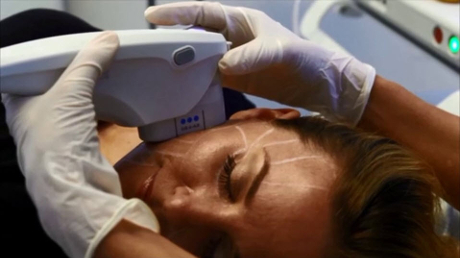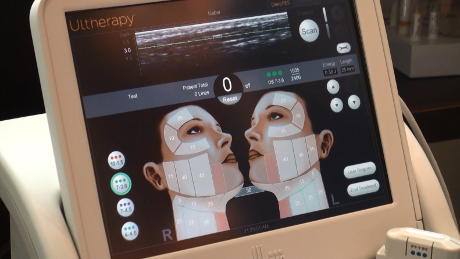The Ultherapy® Difference
TonicMD Beauty & Medspa is proud to offer a different kind of lift: Ultherapy®!
It’s a non-invasive treatment that uses ultrasound to provide natural, gradual results.
What is ultherapy?
ultrasound, not surgery
FDA-Cleared for lifting
Only Ultherapy is FDA-cleared to non-invasively lift skin on the neck, under the chin, and on the brow—and also improve lines and wrinkles on the décolletage! 1,2 No wonder there have been more than a million treatments delivered worldwide.


A Non-invasive procedure
For those looking for an alternative to a surgical facelift, Ultherapy provides proven results in a single treatment for most patients. Learn how to treat your loose skin without surgery, without impacting the surface of your skin, and without downtime.1-3,5,6

Frequently Asked Questions
Ultherapy is the only non-invasive treatment cleared by the FDA for lifting the skin on the neck, chin, and brow, and improving lines and wrinkles on the décolletage. Ultherapy uses microfocused ultrasound to lift and tighten loose skin over time, without any downtime.1-4
Ultherapy is a non-invasive cosmetic procedure that uses time-tested ultrasound technology to stimulate the formation of new collagen deep below the skin’s surface. The production of new collagen takes time, so results can become more apparent over two to three months, even up to six months. The procedure takes about 30 to 90 minutes, depending on the area treated, and there is no downtime afterward. It is also the only non-invasive procedure to use ultrasound imaging, which allows practitioners to actually see the layers of tissue targeted during the treatment and ensure the energy is deposited precisely to where it will be most beneficial.2,4,6,7
Ultherapy treats the deep foundational layer addressed in cosmetic surgery, but won’t duplicate the results of a surgical facelift. Ultherapy is a great alternative, however, especially for those not ready for surgery.2-4,8
Ultherapy uses sound energy—tried-and-true ultrasound—which has unique properties that allow it to bypass the surface of the skin to treat depths not matched by any other non-invasive cosmetic device. Ultherapy ultrasound stimulates collagen production in the skin’s foundation, resulting in a clinically significant lift of tissue over two to three months. Some lasers rely on light energy, which cannot reach deeper skin layers. Typically, laser treatments also only treat superficial skin and are not FDA-cleared to lift skin.2,6,7
Since the procedure stimulates a person’s own collagen production, how long the results last depends on the individual. While results appear over two to three months, they can last up to a year or more. The treatment produces new collagen on the inside, but the individual’s natural aging process will dictate how long that translates into visible results on the outside. Future touch-up treatments can help provide more control over the aging process, which varies by individual.2,3,9
As the ultrasound energy is delivered, you may feel tiny amounts of energy being deposited to precise depths, stimulating the collagen-building process. Comfort levels vary from person to person, but the sensation only lasts while the ultrasound energy is being delivered.3
There may be slight redness that typically resolves within a few hours following the treatment. Some patients may have slight swelling, tingling, or tenderness to the touch, but these are mild and temporary in nature.3
With Ultherapy, there is no downtime. After your procedure, you can resume your normal activities immediately, without having to follow any post-treatment measures.3,4
Pricing for an Ultherapy treatment can vary, depending upon the areas being treated. Of course, the cost of Ultherapy can also vary based on geographic location and by physician practice. Treatment will be customized to meet each patient’s needs, and exact pricing can be discussed during consultation meetings.
Ultherapy is a proven treatment with a well-established safety profile. It is currently marketed worldwide in more than 75 countries, with over 1.5 million treatments performed globally to date. In addition, ultrasound energy has a proven track record, with use in the field of medicine for more than 50 years.
The majority of patients only need one treatment; however, some may benefit from more than one treatment, depending on how much skin laxity they have and their body’s own biological response to the ultrasound and the collagen-building process. Follow-up Ultherapy treatments each year may help maintain results.
Collagen is a natural protein that gives skin its youthfulness by keeping it firm and toned. As we age, collagen breaks down, and the result is a loss of skin strength and elasticity. Ultherapy uses microfocused ultrasound to generate a thermal effect under the skin. The thermal effect essentially jump-starts your body’s own process that produces fresh, new collagen.2,5
A good candidate for Ultherapy is someone with some degree of laxity, to the point of looking, and often feeling, less firm. Loose skin under the neck and under the chin, or lines and wrinkles on the chest, are signals a patient might be a candidate. Typically, those in their 30s and older who have mild to moderate skin laxity are candidates.2,3 While Ultherapy is not a replacement for a surgical facelift, there are many people who want some facial lifting but are not ready for surgery, whether mentally, physically, or financially. There also are younger people who want to “stay ahead of the game,” as well as patients wanting an aesthetic maintenance option.
REFERENCES: 1. Merz and Christie Brinkley inspire women to redefine life’s big moments through new “Milestones of Me” campaign featuring Ultherapy ®. Business Wire website. https://www.businesswire.com/news/home/20190129005028/en/Merz-Christie-Brinkley-Inspire-Women-Redefine-Life%E2%80%99s. Published January 29, 2019. Accessed December 9, 2019. 2. Fabi SG, Joseph J, Sevi J, Green JB, Peterson JD. Optimizing patient outcomes by customizing treatment with microfocused ultrasound with visualization: gold standard consensus guidelines from an expert panel. J Drugs Dermatol. 2019;18(5):426-432. 3. Ulthera Instructions For Use. 4. Fabi SG, Massaki A, Eimpunth S, Pogoda J, Goldman MP. Evaluation of microfocused ultrasound with visualization for lifting, tightening, and wrinkle reduction of the décolletage. J Am Acad Dermatol. 2013;69(6):965-971. 5. Rittie L, Fisher GJ. Natural and sun-induced aging of human skin. Cold Spring Harb Perspect Med. 2015;5(1):a015370. 6. Sasaki GH, Tevez A. Microfocused ultrasound for nonablative skin and subdermal tightening to the periorbitum and body sites: preliminary report on eighty-two patients. Journal of Cosmetics, Dermatological Sciences and Applications. 2012;2(2A):108-116. 7. White WM, Makin IR, Barthe PG, Slayton MN, Gliklich RE. Selective creation of thermal injury zones in the superficial musculoaponeurotic system using intense ultrasound therapy: a new target for noninvasive facial rejuvenation. Arch Facial Plast Surg. 2007;9(1):22-29. 8. Whitney ZB, Zito PM. Anatomy, skin, superficial musculoaponeurotic system (SMAS) fascia. In: StatPearls. Treasure Island, FL: StatPearls Publishing; 2019. https://www.ncbi.nlm.nih.gov/books/NBK519014/. Updated October 27, 2018. Accessed December 9, 2019. 9. Werschler WP, Werschler PS. Long-term efficacy of micro-focused ultrasound with visualization for lifting and tightening lax facial and neck skin using a customized vectoring treatment method. J Clin Aesthet Dermatol. 2016;(9)2:27-33. 10. Alam M, White LE, Martin N, Witherspoon J, Yoo S, West DP. Ultrasound tightening of facial and neck skin: a rater-blinded prospective cohort study. J Am Acad Dermatol. 2010;62(2):262-269.
Request a Consultation
We’re here to help you schedule a consultation today to discuss treatment options and look your very best.
By submitting this form you agree to be contacted via phone, text, or email.*
